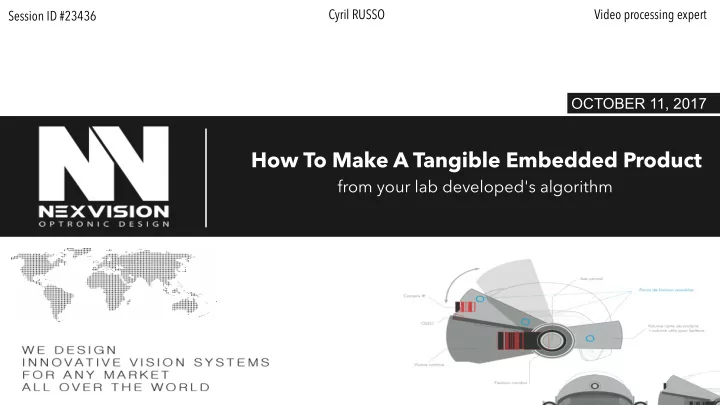

Cyril RUSSO Video processing expert Session ID #23436 OCTOBER 11, 2017 How To Make A Tangible Embedded Product from your lab developed's algorithm
INTRODUCTION Nexvision is an European speciali st in embedded electro-optics system design Our expertise includes optics, multispectral sensors, image processing and analysis, compression and streaming on FPGA, GPU and CPU, on several markets We design complete embedded system
CASE STUDY: VTOL GIMBAL [1/4] An advanced guimbal for situational awareness One of the desired feature requirement: 1. Detect helideck from 2 nautical miles away 2. Track the detected helideck to help the autopilot plan the fight path 3. Detect obstacles on the computed route
CASE STUDY: VTOL GIMBAL [2/4] Typical process: Is it possible to achieve this requirement ? How to perform this task ? Which algorithms ? Which platform ? Environmental conditions ? How to test/assert the implementation ?
Resumes to... How to ft
In this
PC GPU VS EMBEDDED GPU [ obvious diff ] Processing power Power consumption Form factor Location of processing algorithms (CPU, GPU, ISP)
PC GPU VS EMBEDDED GPU [less obvious diff ] Managing the industrial image sensors (not MIPI) and their bandwidth Signal processing (pre/post processing and comp. offoading) Is an additional different sensor more effcient to simplify further processing?
PC GPU VS EMBEDDED GPU [less obvious diff ] FPGA based ISP for the other sensor types (linear, SWIR/Thermal/THz, beam forming radar, ...) High speed feedback loop and signal latency optimization Backing up processing results for subsequent error analysis and feedback reporting
INDUSTRIAL PRODUCT DESIGN PROCESS Before starting the process 1. Profle the algorithm on a Jetson dev board 2. Does it run within the given latency budget ? Yet it's a... Bad idea: To expect the input signal from the embedded system to match the lab's test sequences. Bad idea: Using “black boxes” Good idea: To specify type and format of the input signal (dynamic range, SNR, frame-rate)
STRATEGY FOR ALGORITHM FITTING Is it possible to move part of it in the pre-processing part ? Rule of thumb: Ease of development: CPU > GPU > FPGA > ASIC Processing speed & dev cost: ASIC > FPGA > GPU > CPU Else => Required embedded power w/technical constraints (power consumption / weight / size / environment)
CASE STUDY: VTOL GIMBAL [3/4] Tracking algorithm could not run in realtime with the selected 12MP image sensor Algorithm profling charged the feature point extraction code for half of the processing time Optimizing the algorithm more would have used too many time and gains were asymptotically decreasing. Instead, we moved the HOG computation code in the FPGA's ISP The GPU relaxed and we could focus on other algorithms optimization.
CASE STUDY: VTOL GIMBAL [4/4] Which platform ? 3 IS + 2 FPGA + 3 Tegra K1 SOC 1. Tegra K1 because industrial temp condition 2. 2 GPU because aero safety requirement of independent algorithms 3. One FPGA to deal with 3 IS preprocessing and computing HOG Which environmental conditions and how to test/assert the implementation ? 1. Build only one prototype that'll be used fight tests used to record test sequences and capture env conditions, vibration, exposure time, contrast, dynamic range in real conditions 2. Then build the product
INDUSTRIAL PRODUCT DESIGN PROCESS Design of a frst electronic board (and mechanical structure) for a prototype Usually reuse IP as it saves dev. time and TTM Development of: 1. Hardware boards 2. Firmware for the ISP chip 3. Software stack for the CPU 4. Signal analysis stack for the GPU 5. Test/reporting stack for all components
TIME SAVING IN IND. PRODUCT DESIGN Don't double spend your product development budget 1. Use the frst prototype to tests all the crazy ideas you have 2. Capture as much data as possible from all your sensors 3. Don't skip the input signal preprocessing step 4. But don't re-invent the wheel for the ISP code 5. No more 3+ steps development 6. Use your customers as beta testers, they love it "we'll see later" is a bad motto.
Usual process 2 steps process
CONCLUSION No black box. Straight to the product. Real-world input signal. Early customer implication in project.
CONTACT
Recommend
More recommend